You'll find that making musk fragrances without animal products aligns with modern ethical values while offering superior consistency and sustainability. Traditional musk harvesting from deer became problematic and unsustainable, leading perfumers to embrace botanical and synthetic alternatives. These cruelty-free options provide the same luxurious scent profiles you love, often with better stability and controlled quality. The world of animal-free musk opens up endless creative possibilities for your signature scent.
The Evolution of Musk in Modern Perfumery

While natural musk once dominated the fragrance industry, today's perfumery relies almost entirely on synthetic alternatives.
You'll find that this shift began in the early 20th century when Swiss chemist Albert Baur accidentally discovered synthetic musk while working on TNT development.
This breakthrough couldn't have come at a better time. The traditional harvesting of musk from deer had become both ethically problematic and unsustainable, threatening the species' survival.
Botanical musk alternatives are gaining popularity as sustainable options.
Now, you can experience the same luxurious, sensual scent through various synthetic options – from nitro musks to macrocyclic compounds.
These alternatives don't just replicate the original scent; they've expanded the perfumer's palette, offering consistent quality and unlimited production potential.
What's more, they've made these prestigious fragrances more accessible while protecting endangered musk deer populations.
Understanding Animal-Free Musk Alternatives
As the fragrance industry evolves, you'll find an expanding array of animal-free musk alternatives that deliver the same luxurious scent without ethical concerns. You can now choose between sophisticated synthetic options like muscone and civetone, or explore botanical alternatives derived from plant-based essential oils.
Modern musk alternatives offer distinctive qualities that'll enhance your fragrance experience:
- Synthetic musks provide lasting power and consistent scent profiles
- Botanical musks deliver natural, sustainable fragrance notes
- Plant-derived fixatives guarantee your perfume stays fresh throughout the day
When selecting your musk fragrance, you'll want to take into account both performance and safety. The traditional extraction of musk from musk deer glands has contributed to their endangered status. While traditional synthetic musks may cause skin sensitivity, newer "smart" synthetics and plant-based options offer safer alternatives without compromising on that rich, warm scent you're seeking.
Environmental Impact of Synthetic Musk Production

Despite their appealing scent profiles, synthetic musks pose significant environmental challenges you should know about. These chemicals don't break down easily and persist in water bodies, soil, and air for extended periods.
You'll find them accumulating in rivers, lakes, and even indoor environments due to their widespread use in consumer products.
What's particularly concerning is how synthetic musks affect wildlife. They build up in the tissues of aquatic organisms, from fish to shellfish, disrupting entire ecosystems.
When you consider that levels have dramatically increased in North American lake sediments over the past 15 years, it's clear why regulatory bodies are taking action.
As a result, manufacturers are now being pushed to develop more sustainable alternatives that won't harm our environment or the creatures living in it. Companies like BASF are leading the way by introducing bio-based synthetic musks that utilize renewable materials.
Cruelty-Free Perfume Making at Home
You'll need just basic kitchen tools like a double boiler, measuring spoons, and small containers to start making your own cruelty-free perfumes at home.
Plants and botanical extracts offer excellent natural alternatives to animal-derived musk, with ingredients like candelilla wax replacing beeswax and sweet almond oil serving as your carrier base.
These natural substitutes not only align with vegan values but also let you create unique, personalized fragrances while maintaining complete control over the ingredients.
Simple Equipment Needed
Creating cruelty-free perfumes at home requires just a handful of basic tools to get started.
You'll need precise measurement tools like dropping pipettes and a clean mixing bottle with unscented base for blending your fragrances. Working in a well-ventilated space, you can organize your materials on staging trays while keeping safety in mind with protective gloves.
Essential items for your perfume-making station include:
- Scent testing strips and note-taking materials to track your successful formulas
- Transfer funnels and tweezers for handling small ingredients precisely
- Roll-on bottles and cleansing alcohol wipes for proper storage and sanitization
With these simple tools, you're ready to explore the world of plant-based scents, essential oils, and natural aromatics to create your signature cruelty-free fragrances.
Natural Botanical Substitutes
When crafting cruelty-free musk fragrances, botanical alternatives offer a compassionate and sustainable approach. You'll find a variety of plant-based ingredients that can create beautiful musk-like scents while aligning with ethical values.
| Base Oil | Essential Oil | Fixative |
|---|---|---|
| Jojoba | Lavender | Candelilla Wax |
| Almond | Geranium | Clary Sage |
| Sweet Orange | Rose Absolute | Chamomile |
| Grapeseed | Jasmine | Vanilla Bean |
| Coconut | Sandalwood | Orris Root |
You can extract these fragrances through various methods, including oil infusion, solar extraction, or heat processing. By choosing botanical substitutes, you're not only creating unique scents but also supporting animal welfare and environmental sustainability. These natural alternatives provide stable, long-lasting fragrances when properly stored and handled.
Essential Ingredients for Vegan Musk Blends
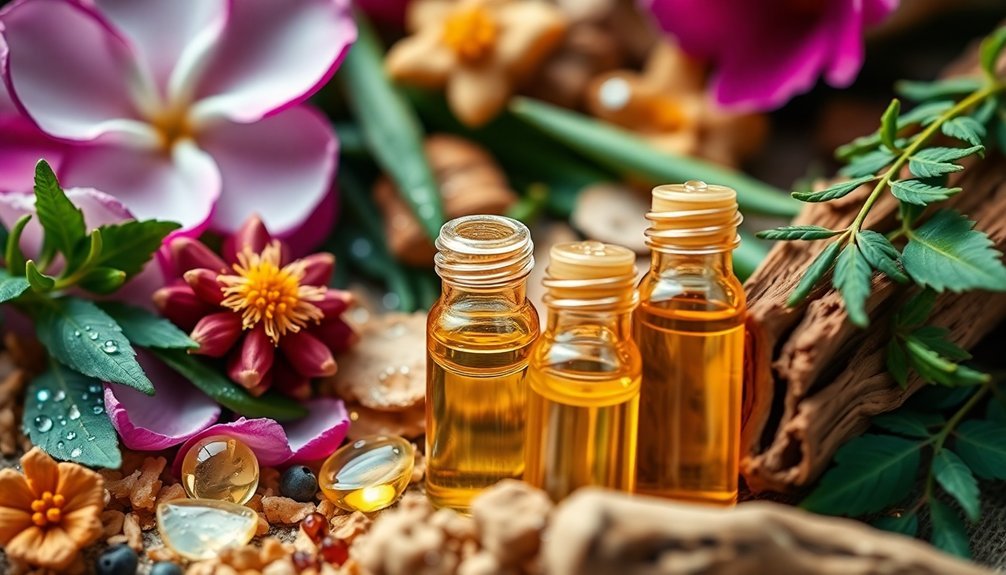
You'll find three main categories of ingredients for creating vegan musk fragrances: plant-based sources like ambrette seeds, lab-created compounds such as Galaxolide and Habanolide, and natural fixatives that help the scent last longer.
When you're selecting your ingredients, consider combining multiple synthetic musks to achieve a more complex and authentic musk aroma.
Your blend can become even more sophisticated by incorporating natural fixatives like benzoin or vanilla absolute, which enhance the longevity of your vegan musk creation.
Plant-Based Musk Sources
As perfumers seek ethical alternatives to traditional animal-derived musks, plant-based sources have emerged as a cornerstone of vegan fragrance creation. The ambrette plant, native to Asia, offers a delicate and sweet musk aroma through its seeds, while providing a sustainable solution for eco-conscious consumers.
You'll find these natural musks deliver complex aromatic profiles that rival their animal-derived counterparts:
- A soft, intimate sensuality that enhances skin-like warmth
- Fresh almond milk accords with fruity green undertones
- Deep, woody notes that add lasting power to perfumes
Lab-Created Aromatic Compounds
Modern perfumery has revolutionized musk fragrances through innovative lab-created compounds that perfectly mimic natural musk scents.
You'll find three main categories of synthetic musks in today's fragrances: nitro musks, polycyclic musks, and macrocyclic musks, each offering unique scent profiles.
Popular synthetic compounds like Galaxolide, Muscone, and Isoeugenol deliver the rich, animalistic notes you'd expect from traditional musk, while maintaining ethical standards.
You can experience these intriguing aromas through carefully engineered molecules such as Habanolide, Exaltolide, and Ethylene Brassylate.
These synthetics guarantee your fragrance remains consistent and long-lasting while blending seamlessly with other scent ingredients.
Natural Fixative Materials
While synthetic musks offer consistent performance, nature provides remarkable plant-based alternatives that serve as powerful fixatives in vegan fragrances.
You'll find these botanical treasures deliver comparable longevity while adding rich, complex layers to your perfume blends. From the woody warmth of ambrette seeds to the earthy depth of labdanum, these natural fixatives create enchanting aromas that rival traditional animal-derived musks.
Consider these sensual plant-based options:
- Hibiscus Abelmoschus seeds, offering green, woody notes with a warm musky undertone
- Costus root, bringing an earthy sweetness that perfectly mimics animal musk
- Labdanum resin, contributing rich, amber-like depth with subtle animalic qualities
These ingredients not only anchor your fragrances but also align with cruelty-free values while providing therapeutic benefits like stress relief and emotional grounding.
Safety Guidelines for DIY Musk Fragrances
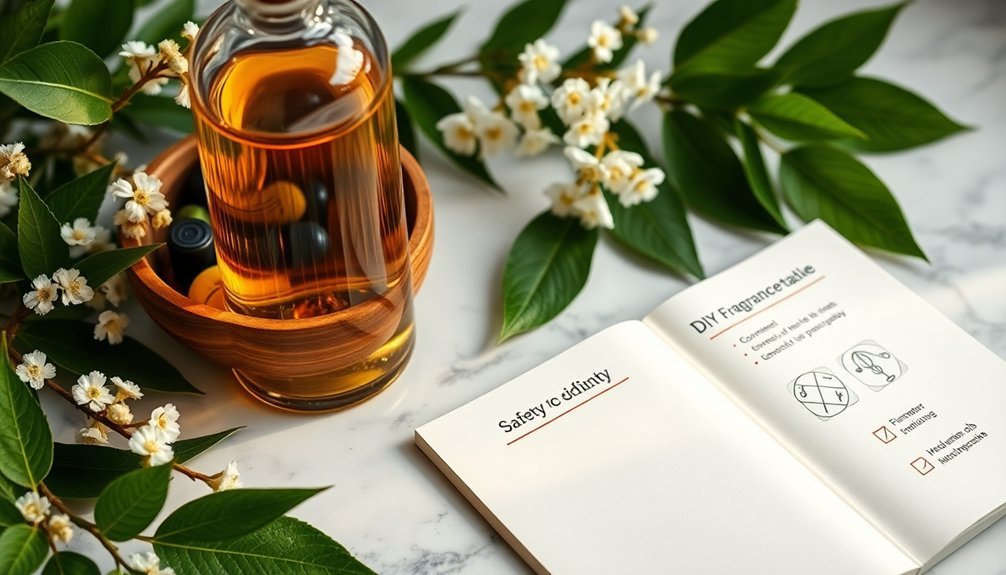
Creating DIY musk fragrances requires strict adherence to safety protocols to prevent adverse reactions and protect both your health and the environment.
Before using any essential oils, you'll need to perform allergy tests by applying a diluted drop to your skin and monitoring for reactions over 48 hours.
Don't apply pure oils directly – always use carrier agents like perfumer's alcohol or fractionated coconut oil. If you're fair-skinned, be cautious with citrus oils as they increase sun sensitivity.
When handling fragrance materials, work in well-ventilated areas and wear protective equipment, including goggles and chemical-resistant gloves.
If spills occur, contain them with sand or inert powder.
Consider avoiding synthetic musks altogether, as they've been linked to respiratory issues, cancer risks, and environmental concerns, particularly in aquatic ecosystems.
Botanical Sources for Natural Musk Notes
Natural perfumers have discovered several plant-based alternatives that capture musk's prized fragrance characteristics without harming animals.
You'll find ambrette seeds, derived from hibiscus, offering sweet, floral undertones that provide a delicate musky essence. Other botanical sources like musk mallow seeds deliver powdery notes, while dark resins such as labdanum create deeper, richer profiles.
When crafting natural musk fragrances, you can expect:
- Sweet, grain-like notes from ambrette seeds that blend perfectly with floral compositions
- Earthy depth from vetiver and patchouli that enhance the traditional musk experience
- Fresh, leafy undertones from green musk alternatives that invigorate your senses
These botanical ingredients create long-lasting fragrances while maintaining ethical standards in modern perfumery.
Synthetic Musk Compounds and Their Properties
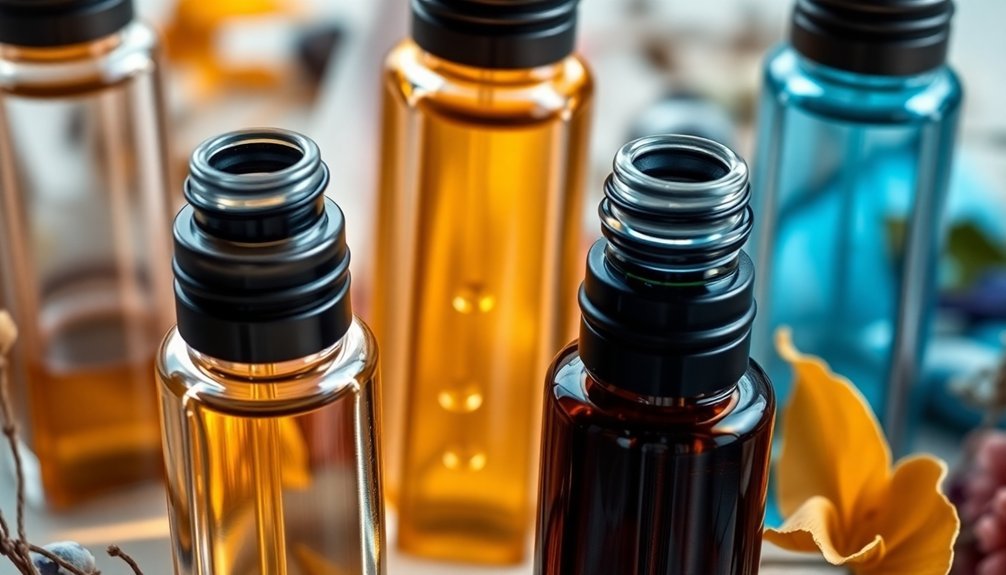
You'll find that synthetic musks, primarily dominated by polycyclic and nitro compounds, feature complex molecular structures designed to mimic natural musk's aromatic properties.
Their chemical composition offers distinct advantages, including greater stability, controlled production, and consistent scent profiles compared to natural alternatives.
Testing results demonstrate high performance regarding longevity and sillage, though you should consider the environmental and health implications of compounds like HHCB and AHTN, which account for a significant portion of the synthetic musk market.
Molecular Structure Analysis
While natural musk compounds have historically been derived from animals, synthetic musk alternatives rely on distinct molecular structures to achieve similar olfactory effects.
Synthetic musks contain large cycloalkanes that create long-lasting scents through different structural types:
- Nitro-musks feature nitrogen-containing compounds like musk ketone and musk xylene
- Polycyclic musks use multiple ring structures, as found in popular fragrances like galaxolide
- Macrocyclic and alicyclic musks employ varying ring sizes to mimic natural musk scents
You'll find these synthetic structures share similar properties with persistent organic pollutants, allowing them to remain stable in the environment and bioaccumulate in tissues.
Their molecular design enables them to bind effectively to scent receptors, though this same characteristic also contributes to their environmental persistence.
Chemical Composition Benefits
Building on our understanding of molecular structures, synthetic musks offer distinct advantages in modern fragrance production.
You'll find three main types – polycyclic, nitro, and macrocyclic musks – each providing unique benefits for fragrance formulation. Polycyclic musks like Galaxolide (HHCB) and Tonalide (AHTN) dominate the market, making up most of the annual production.
These compounds give you precise control over fragrance intensity and longevity in your products. They're particularly effective in personal care items, with about 80% of products containing at least one synthetic musk.
While nitro musks have fallen out of favor due to safety concerns, newer synthetic alternatives provide improved stability and consistency. This allows you to create reliable, standardized fragrances without relying on animal-derived ingredients.
Performance Testing Results
Through extensive laboratory testing, synthetic musk compounds demonstrate both impressive performance characteristics and concerning environmental impacts.
When you use these fragrances, you'll notice they last notably longer than natural alternatives, often persisting on your skin and clothes for several days.
Testing results show these compounds' remarkable stability and effectiveness:
- They maintain scent intensity even after multiple washes
- They perform consistently across various product formulations
- They deliver reliable fragrance profiles in different environmental conditions
However, laboratory analyses have detected these compounds in concerning places – from wastewater to human tissues.
Testing reveals they're particularly prevalent near treatment plants and in urban areas.
While they're cost-effective and stable, their bioaccumulation in the environment and human body raises important questions about long-term safety.
Creating Signature Musk Accords
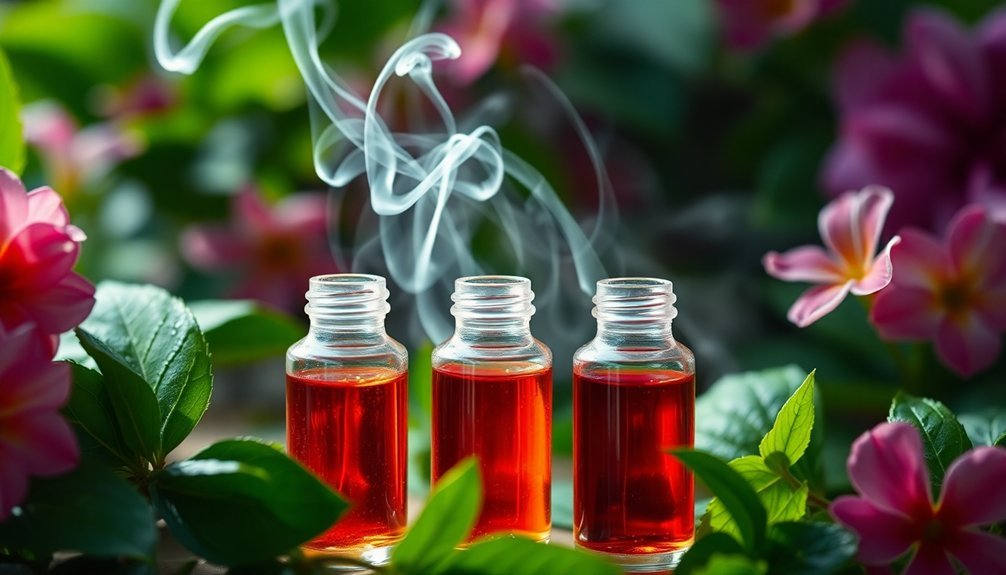
As modern perfumery evolves beyond traditional animal-derived ingredients, creating signature musk accords has become an art that combines synthetic and botanical elements. You'll find that developing your unique musk accord requires careful balancing of components like Galaxolide for clean sweetness and Habanolide for airy metallics.
| Musk Type | Key Components | Best Usage |
|---|---|---|
| Fresh | Habanolide, Helvetolide | Light, airy fragrances |
| Warm | Exaltolide, Ethylene Brassylate | Skin-like scents |
| Natural | Ambrette seed, Plant resins | Clean beauty blends |
| Complex | Mixed synthetics, Botanicals | Signature perfumes |
You can create distinctive signatures by combining synthetic musks with botanical elements like ambrette seed extracts. This approach offers both the consistency of synthetic materials and the unique character of natural ingredients, while maintaining ethical standards in modern perfumery.
Sustainable Practices in Fragrance Making
Sustainable fragrance making has evolved into an all-encompassing approach that extends far beyond ingredient selection.
When you choose a sustainable fragrance, you're supporting practices that protect both the environment and communities worldwide.
Modern fragrance production embraces green chemistry and innovative extraction techniques that minimize environmental impact while maintaining quality.
You'll find many brands now implementing:
- Zero-waste production systems that reduce water usage and energy consumption
- Biotechnology solutions that create complex scents without depleting natural resources
- Eco-friendly packaging with refill options and biodegradable materials
Balancing Ethics and Artistry in Perfumery
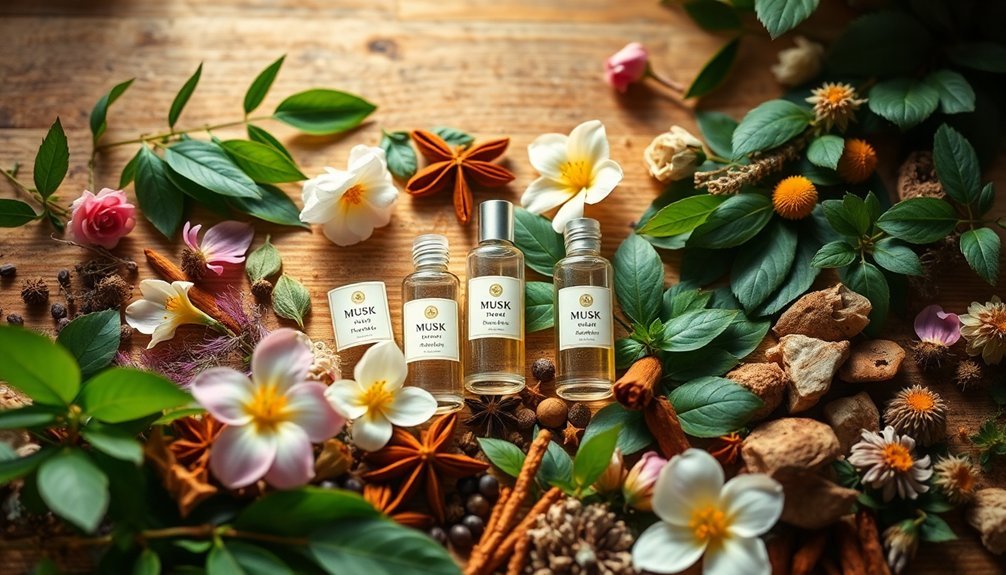
While creating exquisite fragrances remains an art form, modern perfumers have proven that ethics and artistry can coexist beautifully.
You'll find that synthetic and botanical musks can replicate the complex, deep aromas traditionally achieved through animal-derived ingredients, without compromising on quality or longevity.
The shift toward cruelty-free alternatives hasn't limited creative possibilities – it's expanded them. You can now experience unique scent profiles crafted from innovative plant essences and lab-created compounds that serve as powerful base notes and fixatives.
By choosing these ethical alternatives, you're supporting perfumers who prioritize both artistic excellence and animal welfare.
The wide range of available botanical materials means you don't have to sacrifice sophistication for sustainability in your fragrance choices.
Quality Control for Homemade Musk Scents
When creating homemade musk fragrances, proper quality control guarantees both safety and authenticity in your final product. You'll need to verify your ingredients through GC-MS analysis and maintain detailed sourcing records.
Consider working with third-party labs to confirm the purity of your materials.
Your quality control process should include:
- Conducting blind tests with expert panels to evaluate your scent's olfactory profile
- Performing stability tests under various environmental conditions
- Testing packaging materials for chemical compatibility and UV protection
Don't skip the essential stability testing phase. You'll want to subject your perfume to different temperatures, light exposures, and storage conditions to determine its shelf life.
Remember to collect user feedback to continuously improve your formulation while maintaining consistent quality across all batches.
Storage and Preservation of Animal-Free Musks
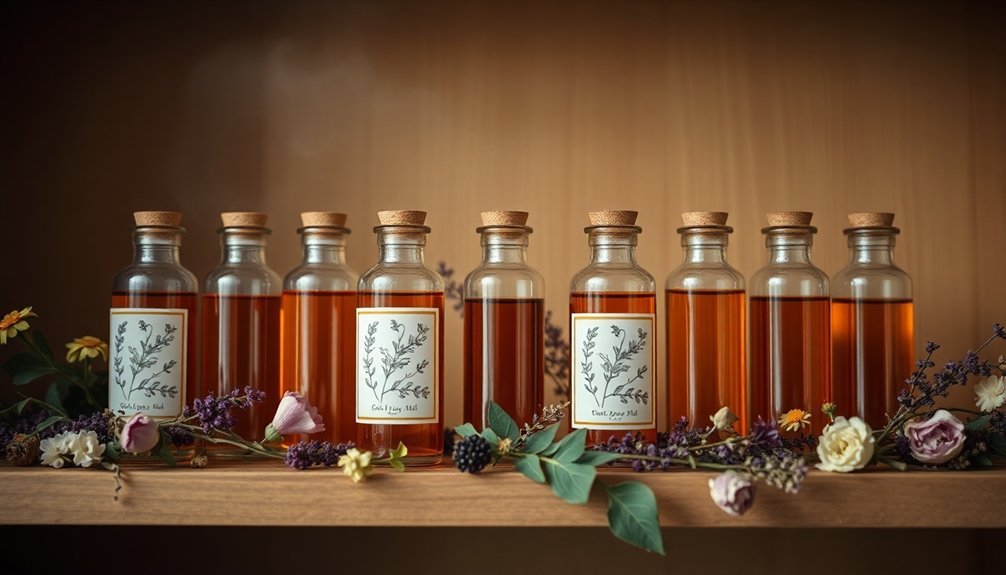
Proper storage and preservation techniques are essential for maintaining the potency and quality of animal-free musk fragrances. You'll find that plant-based musks like ambrette require distillation and 70% ethanol preservation, while synthetic musks offer more stability with fewer storage demands.
| Storage Type | Requirements | Best For |
|---|---|---|
| Glass Containers | Cool, dry space | All musk types |
| Ethanol Solution | 70% concentration | Plant-based musks |
| Ventilated Storage | Room temperature | Synthetic blends |
| Sealed Bottles | Dark location | Botanical essences |
When handling your musk preservatives, always work in well-ventilated areas and wear protective gear. You'll need to regularly check for signs of degradation and maintain proper documentation of your preservation methods. Store your musks in non-reactive glass containers and keep detailed notes on ingredients and processes used.
Frequently Asked Questions
How Long Does Synthetic Musk Fragrance Typically Last on Skin?
You'll notice synthetic musk fragrances typically last 8-12 hours on your skin. They can linger even longer on your clothes, often lasting several days due to their strong fixative properties.
Can Synthetic Musk Trigger Migraines in Sensitive Individuals?
Yes, if you're sensitive to fragrances, synthetic musk can trigger migraines. You'll likely experience headaches when exposed to these compounds, especially in concentrated forms, due to your body's immune and nervous system responses.
Are Synthetic Musks Compatible With Natural Essential Oils?
Yes, you'll find synthetic musks are generally compatible with essential oils. They can stabilize and enhance natural scents, acting as fixatives. Just be careful with specific combinations, as some musks may clash with certain oils.
Which Cultures Traditionally Value Musk in Their Ceremonial Practices?
You'll find musk deeply valued in Hindu religious ceremonies, Middle Eastern hospitality rituals, and ancient Egyptian spiritual practices. These cultures traditionally use musk for its divine connections and powerful fragrance properties.
Do Synthetic Musks Perform Differently in Various Climate Conditions?
You'll notice synthetic musks perform differently across climates. They're more volatile in warm conditions, less detectable in remote Arctic air, and their concentrations vary with population density and local environmental factors.
In Summary
You've learned that creating musk fragrances without animal products isn't just about ethics – it's about innovation and sustainability. By choosing synthetic or botanical alternatives, you're supporting cruelty-free practices while still enjoying complex, beautiful scents. Whether you're crafting your own blends or purchasing ready-made fragrances, you're contributing to a future where luxurious perfumes don't come at nature's expense.

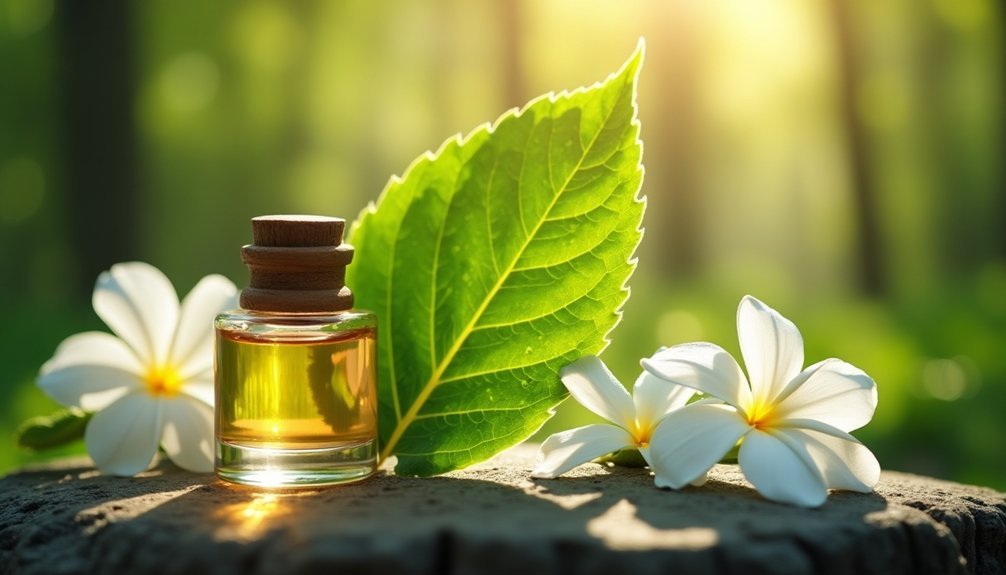
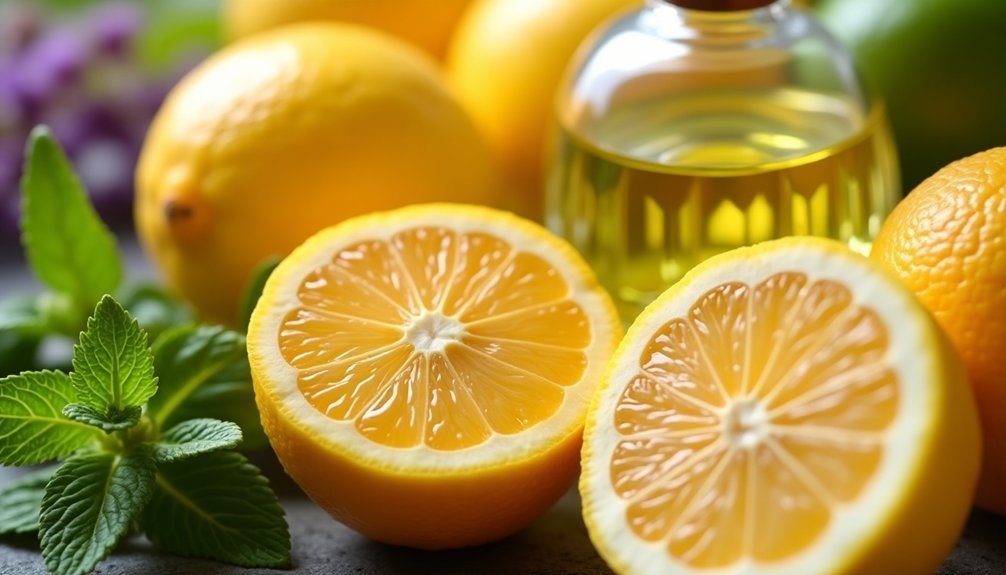
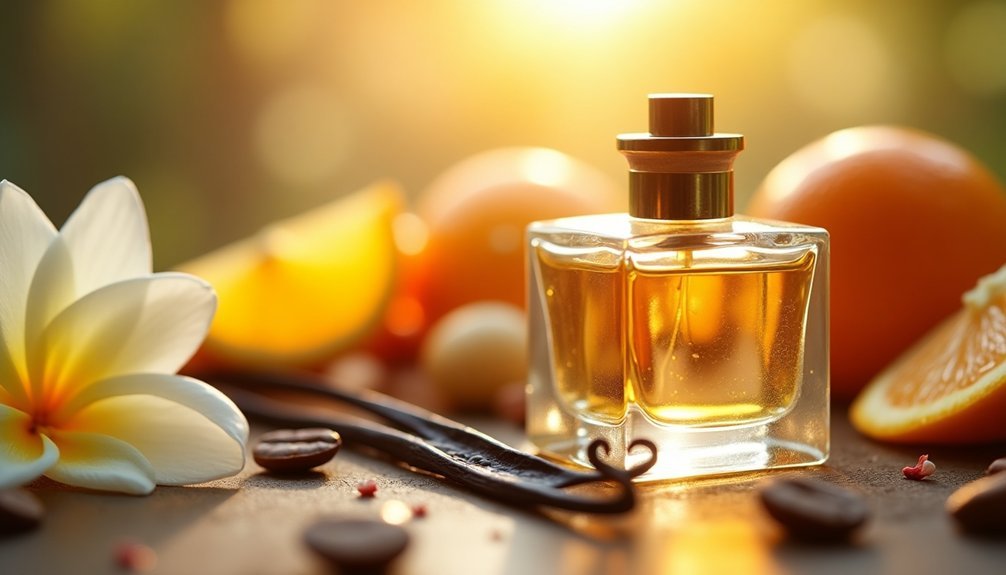

Leave a Reply